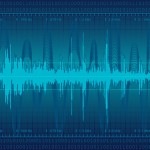Difference between revisions of "Frequency"
| Line 20: | Line 20: | ||
The SI unit for period is the second.[http://en.wikipedia.org/wiki/Frequency] | The SI unit for period is the second.[http://en.wikipedia.org/wiki/Frequency] | ||
| − | + | ==See also== | |
| + | *'''''[[Amplitude]]''''' | ||
| + | *'''''[[Oscillation]]''''' | ||
==References== | ==References== | ||
* Giancoli, D.C. (1988), Physics for Scientists and Engineers (2nd ed.), Prentice Hall, ISBN 013669201X | * Giancoli, D.C. (1988), Physics for Scientists and Engineers (2nd ed.), Prentice Hall, ISBN 013669201X | ||
Revision as of 22:49, 22 November 2013
Frequency is the number of occurrences of a repeating event per unit time. It is also referred to as temporal frequency. The period is the duration of one cycle in a repeating event, so the period is the reciprocal of the frequency.
Definitions and units
For cyclical processes, such as rotation, oscillations, or waves, frequency is defined as a number of cycles, or periods, per unit time. In physics and engineering disciplines, such as optics, acoustics, and radio, frequency is usually denoted by a Latin letter f or by a Greek letter ν (nu).
In SI units, the unit of frequency is hertz (Hz), named after the German physicist Heinrich Hertz. For example, 1 Hz means that an event repeats once per second.
A traditional unit of measure used with rotating mechanical devices is the revolutions per minute, abbreviated rpm. 60 rpm equals one hertz.[1]
The period is usually denoted as T, and is the reciprocal of the frequency f:
The SI unit for period is the second.[1]
See also
References
- Giancoli, D.C. (1988), Physics for Scientists and Engineers (2nd ed.), Prentice Hall, ISBN 013669201X
- Davies, A. (1997). Handbook of Condition Monitoring: Techniques and Methodology. New York: Springer. pp. 275. ISBN 9780412613203. http://books.google.com/books?id=j2mN2aIs2YIC&pg=RA1-PA275.
- Bakshi, K.A.; A.V. Bakshi, U.A. Bakshi (2008). Electronic Measurement Systems. US: Technical Publications. pp. 4-14. ISBN 9788184312065. http://books.google.com/books?id=jvnI3Dar3b4C&pg=PT183.
- Elert, Glenn; Timothy Condon (2003). "Frequency Range of Dog Hearing" (in English). The Physics Factbook. http://hypertextbook.com/facts/2003/TimCondon.shtml. Retrieved 2008-10-22.
External links
- National Research Council of Canada: Femtosecond comb; The measurement of optical frequencies
- Conversion: frequency to wavelength and back
- Conversion: period, cycle duration, periodic time to frequency
- Keyboard frequencies = naming of notes - The English and American system versus the German system
- Teaching resource for 14-16yrs on sound including frequency
- A simple tutorial on how to build a frequency meter
- Frequency - diracdelta.co.uk - javascript calculation.

